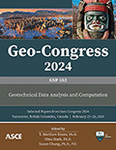Implementation of a New Strain Softening Constitutive Model in the Material Point Method for the Simulation of Retrogressive Failure in Sensitive Clays
Publication: Geo-Congress 2024
ABSTRACT
Sensitive clays experience significant strain-softening behavior, that is, when subjected to large strains. They disintegrate into a remolded liquid with diminutive shear strength. When a slope begins to fail, the remolded clay keeps moving away from its original position causing subsequent failures, resulting in catastrophic aftermath. The capability to reproduce realistic strain-softening characteristics in the constitutive soil model is necessary for more accurate numerical slope analyses in sensitive clays. This paper illustrates a simple yet practical constitutive model specially developed for simulating the strain-softening behavior of sensitive clays. The model is then implemented in Anura3D, an open-source software that uses the material point method to simulate large deformations. The model is tested using the failure of a previously occurred retrogressive failure in sensitive clay. Finally, the model’s predictions have been compared with the actual post-failure run out of the landslide, and the results show that the model is reasonable and practical.
Get full access to this article
View all available purchase options and get full access to this chapter.
REFERENCES
Anura3D MPM Research Community. 2022. “<www.anura3d.com>.”.
Bjerrum, L. 1955. “Stability of Natural Slopes in Quick Clay.” Géotechnique, 5 (1): 101–119. https://doi.org/10.1680/geot.1955.5.1.101.
Carson, M. A. 1977. “On the retrogression of landslides in sensitive muddy sediments.” Canadian Geotechnical Journal, 14: 582–602. https://doi.org/10.1139/t77-059.
Ceccato, F., A. Yerro, and M. Martinelli. 2018. “Modelling soil-water interaction with the material point method. Evaluation of single-point and double-point formulations.” Numerical methods in geotechnical engineering IX, 351–358. CRC Press.
Locat, A., S. Leroueil, A. Fortin, D. Demers, and H. P. Jostad. 2015. “The 1994 landslide at Sainte-Monique, Quebec: Geotechnical investigation and application of progressive failure analysis.” Canadian Geotechnical Journal, 52 (4): 490–504. Canadian Science Publishing. https://doi.org/10.1139/cgj-2013-0344.
Mitchell, R. J., and A. R. Markell. 1974. “Flowsliding in Sensitive Soils.” Canadian Geotechnical Journal, 11: 11–31.
Odenstad, S. 1951. “The landslide in Skoptrop on the Lidan river.”.
Oliver, J., and A. E. Huespe. 2004. “Continuum approach to material failure in strong discontinuity settings.” Comput Methods Appl Mech Eng, 193 (30–32): 3195–3220. https://doi.org/10.1016/j.cma.2003.07.013.
Rosenqvist, I. T. 1953. “Considerations on the sensitivity of norwegian quick-clays.” Géotechnique, 3 (5): 195–200.
Rots, J., P. Natua, G. Kuster, and J. Blaauwendraad. 1985. “Smeared crack approach and fracture localization in concrete.” HERON 30, 1: 3–48.
Shan, Z., W. Zhang, D. Wang, and L. Wang. 2021. “Numerical investigations of retrogressive failure in sensitive clays: revisiting 1994 Sainte-Monique slide, Quebec.” Landslides, 18 (4): 1327–1336. Springer Science and Business Media Deutschland GmbH. https://doi.org/10.1007/s10346-020-01567-4.
Skempton, A. W., and R. D. Northey. 1952. “The sensitivity of clays.” Géotechnique, 3 (1): 30–52. https://doi.org/10.1680/geot.1952.3.1.30.
Soga, K., E. Alonso, A. Yerro, K. Kumar, and S. Bandara. 2016. “Trends in large-deformation analysis of landslide mass movements with particular emphasis on the material point method.” Geotechnique, 66 (3): 248–273. Thomas Telford Services Ltd. https://doi.org/10.1680/jgeot.15.LM.005.
Sulsky, D., Z. Chenb, and H. L. Schreyer. 1994. “A particle method for history-dependent materials.” Comput Methods Appl Mech Eng, 118 (1–2): 179–196. https://doi.org/10.1016/0045-7825(94)90112-0.
Tran, Q. A., and W. Sołowski. 2019. “Generalized Interpolation Material Point Method modelling of large deformation problems including strain-rate effects – Application to penetration and progressive failure problems.” Comput Geotech, 106: 249–265. Elsevier Ltd. https://doi.org/10.1016/j.compgeo.2018.10.020.
Urmi, Z. A., A. Saeidi, R. V. P. Chavali, and A. Yerro. 2023a. “Failure mechanism, existing constitutive models and numerical modeling of landslides in sensitive clay: a review.” Geoenvironmental Disasters, 10 (1): 14. https://doi.org/10.1186/s40677-023-00242-9.
Urmi, Z. A., A. Saeidi, A. Yerro, and R. V. P. Chavali. 2023b. “Effect of strain softening on the prediction of post-failure runout in sensitive clay landslide.” NUMGE 2023: 10th European Conference on Numerical Methods in Geotechnical Engineering. London.
Urmi, Z. A., A. Saeidi, A. Yerro, and R. V. P. Chavali. 2023c. “Prediction of post-peak stress-strain behavior for sensitive clays.” Eng Geol, 323: 107221. https://doi.org/10.1016/j.enggeo.2023.107221.
Wang, C., B. Hawlader, D. Perret, and K. Soga. 2020. “Effects of geometry and soil properties on type and retrogression of landslides in sensitive clays.” Géotechnique, 1–15. Thomas Telford Ltd. https://doi.org/10.1680/jgeot.20.p.046.
Yerro, A., K. Soga, and J. Bray. 2019. “Runout evaluation of Oso landslide with the material point method.” Canadian Geotechnical Journal, 56 (9): 1304–1317. https://doi.org/10.1139/cgj-2017-0630.
Yuan, W. H., K. Liu, W. Zhang, B. Dai, and Y. Wang. 2020. “Dynamic modeling of large deformation slope failure using smoothed particle finite element method.” Landslides, 17 (7): 1591–1603. Springer. https://doi.org/10.1007/s10346-020-01375-w.
Zhang, X., S. W. Sloan, and E. Oñate. 2018. “Dynamic modelling of retrogressive landslides with emphasis on the role of clay sensitivity.” Int J Numer Anal Methods Geomech, 42 (15): 1806–1822. John Wiley and Sons Ltd. https://doi.org/10.1002/nag.2815.
Information & Authors
Information
Published In
History
Published online: Feb 22, 2024
ASCE Technical Topics:
- Analysis (by type)
- Clays
- Constitutive relations
- Engineering fundamentals
- Failure analysis
- Geomechanics
- Geotechnical engineering
- Material mechanics
- Materials engineering
- Mathematics
- Models (by type)
- Simulation models
- Soil analysis
- Soil mechanics
- Soil properties
- Soil stress
- Soils (by type)
- Strain
- Strain hardening and softening
Authors
Metrics & Citations
Metrics
Citations
Download citation
If you have the appropriate software installed, you can download article citation data to the citation manager of your choice. Simply select your manager software from the list below and click Download.
